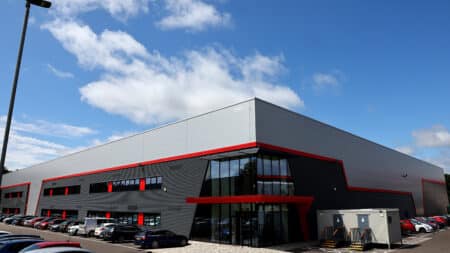
'Not even the best F1 driver in his family' - Pain of being the other Schumacher
He has always been overshadowed by his older brother but Ralf Schumacher’s 50-year story is more layered, and more human, than the stats alone suggest, says Matt Bishop
Will Norfolk-based Lotus bloom under Geely’s new ownership?

Certain companies become indivisible from the location in which they were founded: It would be hard indeed to think of a Ferrari made anywhere other than Maranello, or a Lamborghini not made in Sant’Agata. But, in reality, very few manufacturers stay rooted to one location forever. Porsche did not start its life in Stuttgart any more than did Rolls-Royce begin in Goodwood or Bentley in Crewe. The homes Aston Martin has enjoyed over the years are far too numerous to list here, and it’s just about to open another.
But let us say your company is clearly identified with a single location, but you come to see in time that it’s not actually helping your business? What should you do? Do you regard the place you build your cars as inviolate, part of the brand itself and that to dispense with it would do intolerable and perhaps irreversible damage? Or do you take the view that you should go wherever suits the specific business needs of the company at that time? It’s not an easy question, but in the case of Lotus, I think it should at least be asked.
The Hethel factory is by no means the original home of Lotus. Indeed after Hornsey and Cheshunt, it is the third. But Lotus has been located outside the small Norfolk village for 52 years of the 66 years in which the company has been in existence. Every road car from the original Europa onwards has been built there and every single seater and sports racing car from the legendary DFV-powered Lotus 49 was tested there. Drivers from Jim Clark and Jochen Rindt to Ayrton Senna and Mika Häkkinen tried out their latest racing cars on the quick, flat circuit built on the perimeter roads of this former United States Air Force base. And although much changed by multiple owners, still the history seems to seep out of the place. I go to a lot of automotive production facilities in this job, but none like Lotus, none with a test track within spitting distance of the factory floor. On more than one occasion I have gone there to test some preposterously fast old Lotus racing car and judging by the spectators that spontaneously appeared at the first sound of a DFV, I expect I brought production to a halt. There is passion here of a kind I don’t think I’ve seen anywhere else.
But all the signs are that Lotus is about to undergo the biggest change of its life to date. Almost a year ago news broke that the company had been sold to Chinese multinational Geely to add to a portfolio that already includes Volvo. As everyone knows, Geely has had a startling effect on the Swedish manufacturer, transforming it from a business apparently fated for all time to produce an endless line of plucky also-rans, to one of the most desirable premium brands of all, as worthy a rivals as the largely German opposition could hope not to have.
We know none of Geely’s plans for Lotus, but I imagine it’s safe to say they’re not solely based on producing small numbers of sports cars based on increasingly elderly designs. With Volvo it literally started from scratch and there’s no reason to think the same will not be true for Lotus.
So the question is, if you’re going to start again, would you choose to do so just outside Norwich? On the plus side, I imagine the council would be very keen to keep Lotus local because even today it is a major employer in the region, so I imagine planning would be easier there than most other places it might choose to go, but the location is a problem. Hethel is a very long way from the Midlands heart of the UK motor industry and I understand that it is a limiting factor in recruiting and retaining even the relatively low number of high-quality engineers required at present. But if Lotus is to transform its business into one that, for instance, has the same aspirations as Aston Martin of selling 12,000 cars or more per year, that will require armies of world-class automotive engineers to choose to relocate to the north east of East Anglia. Would it not be better to take a deep breath and relocate closer to where these people are likely already to be found?
I know there are many who will find the suggestion sacrilegious, but I am not suggesting the abandonment of Hethel at all. On the contrary while the headquarters and manufacturing could be better served elsewhere, Hethel provides something else a manufacturer like Aston Martin would kill to own: an FIA-specification test track with, at least so far, little or no noise restrictions, not to mention the relatively quiet and challenging country roads on which the handling of all Lotus road cars has been honed over the last 50 years. Hethel could be retained to develop not just all Lotus road cars, but as a base for rebuilding Lotus’s once-booming automotive consultancy business, sought out by other manufacturers wanting a little Lotus magic to be sprinkled on their products. And of course few would benefit more from this process than Geely’s latest new brand, the Volvo spin-off called Polestar. Polestar will shortly start producing high-performance hybrid and electric cars under its own name with every intention of becoming to Volvo what AMG is to Mercedes-Benz and M is to BMW. And on Geely’s performance to date, I wouldn’t bet against them achieving it.
As for what cars the Geely-financed Lotus should produce, I think the first should be a replacement for the Evora. The current car never had the investment required for it to be a problem Porsche rival, but Geely has the resources to create something truly special – a proper Lotus rival to the Cayman, Boxster and 911 that would sell in volumes and return profits of a kind the current Elise-based range could not imagine. What should it be called? As a former owner, I might be biased, but I always thought ‘Esprit’ had a nice ring to it.

He has always been overshadowed by his older brother but Ralf Schumacher’s 50-year story is more layered, and more human, than the stats alone suggest, says Matt Bishop

Cadillac's Formula 1 entry was approved just 364 days before its first grand prix weekend. We took a look inside its Silverstone base to find out how it's building a brand new team from scratch

Describing this year's championship race as a 'battle' might be slightly over-egging it, writes James Elson

You had to read between the lines at the 2025 Austrian Grand Prix as George Russell dropped hints over about his dissatisfaction, and F1 sent a message to FIA president Mohammed Ben Sulayem